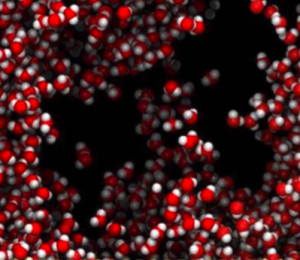J. Muscatello, E. A. Muller, A. A. Mostofi and A. P. Sutton, Multiscale molecular simulations of the formation and structure of polyamide membranes created by interfacial polymerization, J. Membrane Sci. 527, 180 (2017).
One of the greatest societal challenges of the 21st century is to ensure the availability of fresh water to the world’s growing population in the backdrop of significant environmental change. Desalination of sea water to produce fresh water is a promising route to addressing this challenge.
Membranes can be used to desalinate sea water via a process known as reverse osmosis. Pressure is applied to sea water on one side of a selectively permeable membrane that allows water to flow through it, leaving behind the ions that cause sea water to be brackish.
A common type of membrane is a highly cross-linked polyamide thin layer formed by interfacial polymerisation of two monomers in solution. In these materials the separation of water from ions occurs in a thin layer than may only be a few nanometers thick — by contrast, the a human hair is about 10,000 times thicker.
In a paper published recently in the Journal of Membrane Science, Jordan Muscatello has developed a multi-scale model of the interfacial polymerisation process and representative atomic structures of the membrane. Two key observations from this computational study are: (1) the polymerisation process is self-limiting, resulting in a membrane thickness of 5-10 nm, in excellent agreement with experimental measurements; and (2) the membranes form by aggregation of oligomer clusters, with weaker bonding across interfaces between former separate clusters. The resulting morphology may have a direct bearing on transport of small molecules through the membrane where the less dense interfaces may provide easier channels for diffusion.
This work was supported by the BP International Centre for Advanced Materials. Jordan Muscatello is a post-doctoral research associate at Imperial College London and was supervised by Adrian Sutton, Erich Muller and Arash Mostofi.
